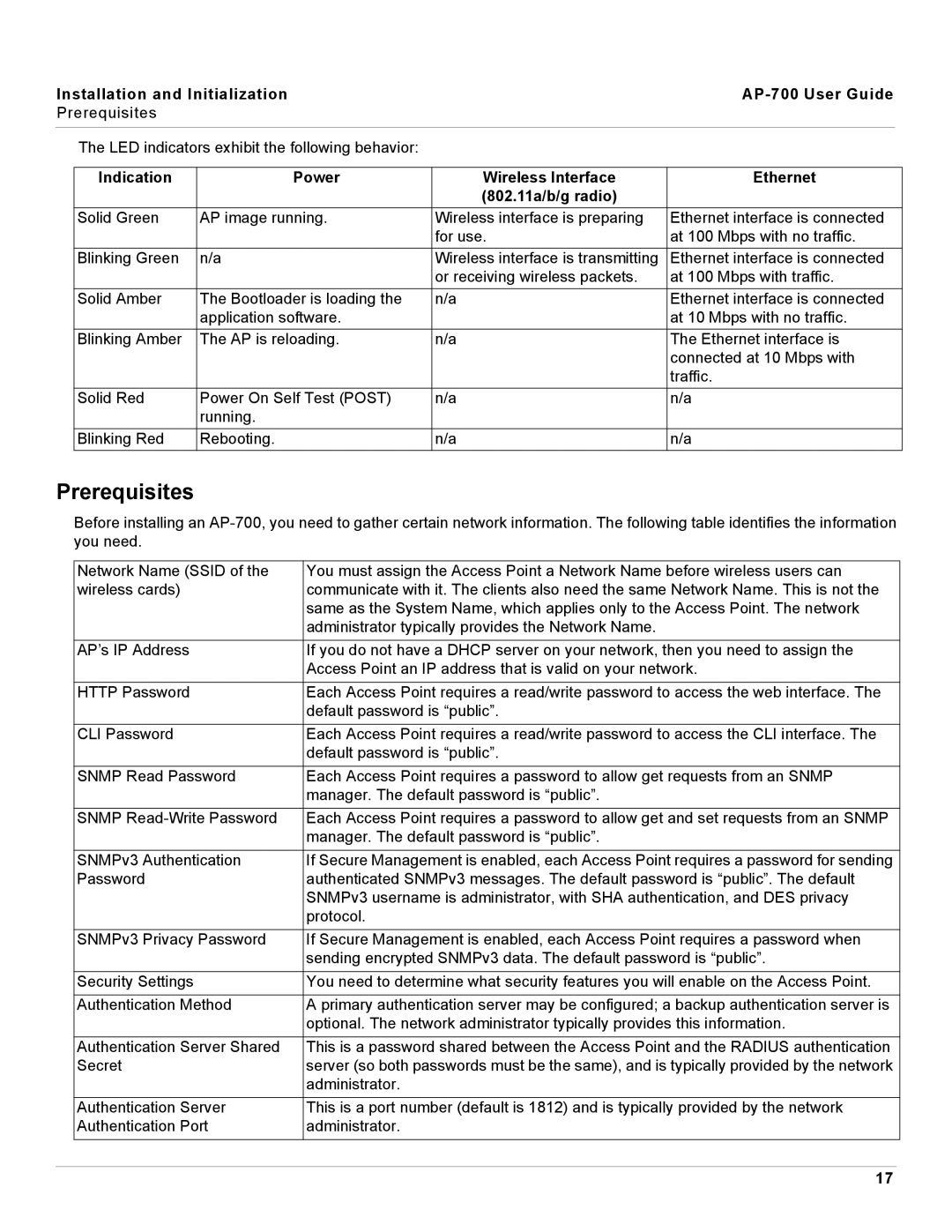Installation and Initialization |
|
|
| ||
Prerequisites |
|
|
|
| |
|
|
|
|
|
|
| The LED indicators exhibit the following behavior: |
|
|
| |
|
|
|
|
|
|
| Indication | Power | Wireless Interface | Ethernet |
|
|
|
| (802.11a/b/g radio) |
|
|
| Solid Green | AP image running. | Wireless interface is preparing | Ethernet interface is connected |
|
|
|
| for use. | at 100 Mbps with no traffic. |
|
| Blinking Green | n/a | Wireless interface is transmitting | Ethernet interface is connected |
|
|
|
| or receiving wireless packets. | at 100 Mbps with traffic. |
|
| Solid Amber | The Bootloader is loading the | n/a | Ethernet interface is connected |
|
|
| application software. |
| at 10 Mbps with no traffic. |
|
| Blinking Amber | The AP is reloading. | n/a | The Ethernet interface is |
|
|
|
|
| connected at 10 Mbps with |
|
|
|
|
| traffic. |
|
| Solid Red | Power On Self Test (POST) | n/a | n/a |
|
|
| running. |
|
|
|
| Blinking Red | Rebooting. | n/a | n/a |
|
Prerequisites
Before installing an
Network Name (SSID of the | You must assign the Access Point a Network Name before wireless users can |
wireless cards) | communicate with it. The clients also need the same Network Name. This is not the |
| same as the System Name, which applies only to the Access Point. The network |
| administrator typically provides the Network Name. |
AP’s IP Address | If you do not have a DHCP server on your network, then you need to assign the |
| Access Point an IP address that is valid on your network. |
HTTP Password | Each Access Point requires a read/write password to access the web interface. The |
| default password is “public”. |
CLI Password | Each Access Point requires a read/write password to access the CLI interface. The |
| default password is “public”. |
SNMP Read Password | Each Access Point requires a password to allow get requests from an SNMP |
| manager. The default password is “public”. |
SNMP | Each Access Point requires a password to allow get and set requests from an SNMP |
| manager. The default password is “public”. |
SNMPv3 Authentication | If Secure Management is enabled, each Access Point requires a password for sending |
Password | authenticated SNMPv3 messages. The default password is “public”. The default |
| SNMPv3 username is administrator, with SHA authentication, and DES privacy |
| protocol. |
SNMPv3 Privacy Password | If Secure Management is enabled, each Access Point requires a password when |
| sending encrypted SNMPv3 data. The default password is “public”. |
Security Settings | You need to determine what security features you will enable on the Access Point. |
Authentication Method | A primary authentication server may be configured; a backup authentication server is |
| optional. The network administrator typically provides this information. |
Authentication Server Shared | This is a password shared between the Access Point and the RADIUS authentication |
Secret | server (so both passwords must be the same), and is typically provided by the network |
| administrator. |
Authentication Server | This is a port number (default is 1812) and is typically provided by the network |
Authentication Port | administrator. |
17
